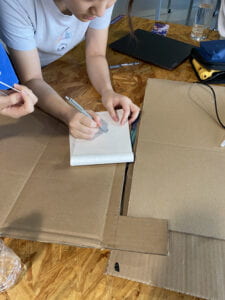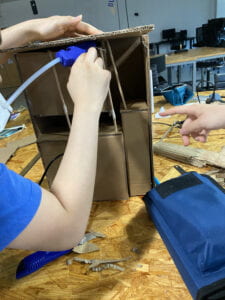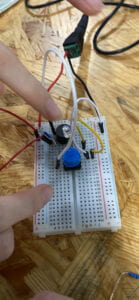A. Blind man’s buff – Nuri Atymtay – Rudi Cossovich
B. My previous project was called “Perfumaker” and the interactive part of it was that you envision a scenery, push a button and it gives you an outcome in a form of a scent. My personal midterm project had lots of intakes from the group project since it was a box, just like the previous, however this time it was a locker for safeguarding. However, this idea has changed into something else with a helmet playing a big role to get to the safe and open it first in a way reminding “spy game”. Furthermore this project had a major switch when we dropped the locker and made it only a game of catching light with a helmet. But, we had to change the helmet’s purpose completely again after the User Testing Session after we discovered a lot of flaws. We have re-created and made improvement to the game of “Blind man’s buff” by making it hard to win.
C. The whole idea of the “Blind man’s buff” is revolved around the fact that a person “it” is searching for people and has a blindfold which is why we needed something for the head. Therefore, helmet was a perfect decision for that and we could modify it easily as well as apply more sensors to it as it can handle more or less weight. We at first wanted to use three distance sensors to help the “it” find player easily but that would make it too easy for the “it” to find people so we only made it in the front instead. At first we had resistors from the previous project of LED lights to catch the light, we removed it and kept the buzzer only so the it informs the “it” that a player is around. We also had a button to start the previous game, however it made no sense for the “it” to have it since the game will start right away when he puts on the blindfold and the helmet. The material that we made it out from was cardboard which is extremely easy to work with.
D. The most challenging part of the whole project was making the helmet. This was due to the fact that we needed bigger surface for the forehead area so that we could attach the distance sensors and the buzzer. Moreover, we were thinking of attaching the circuit to the helmet too, but it was as quickly rejected as it was thought of since it is too dangerous especially when it is wearable device. I personally contributed more to the production and physical work and my partner was responsible for the coding. In addition, I came up with the back story or the concept of the project as being “Blind man’s buff” game. The User Testing has opened our eyes on how impossibly complicated was the idea of the previous project, especially, when it came to the set of the project that was supposed to be a dark room.
int SENSOR_PIN = A0; int SENSOR_PIN2 = A1; int sensorVal1; int sensorVal2; int startTime; const int buttonPin = 2; int buttonState = 0; void setup() { pinMode(SENSOR_PIN, INPUT); // Set sensor pin as an INPUT pin pinMode(SENSOR_PIN2, INPUT ); pinMode(buttonPin, INPUT); Serial.begin(9600); } void loop() { sensorVal1 = analogRead(SENSOR_PIN); sensorVal2 = analogRead(SENSOR_PIN2); buttonState = digitalRead(buttonPin); //if (buttonState == HIGH) { if (sensorVal1 >= 900 or sensorVal2 >= 900){ tone(8, 440, 600); startTime = millis(); } else{ if (millis()-startTime < 14000 && millis()-startTime > 2000){ tone(8, 300, 300); delay(1400); } else if (millis()-startTime > 14000 && millis()-startTime < 22000){ tone(8, 800, 2000); delay(2600); } } //} }
E. In conclusion, the idea of our project was to create an interactive game that makes it challenging for the players to win the game.


























